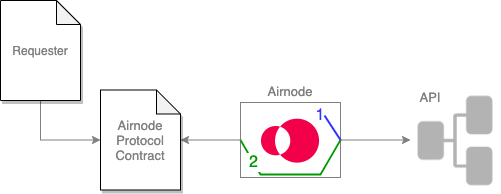# API Security
Airnode can pass along security information (schemes) when making calls to API
operations. These come in two forms, authentication security schemes such as
apiKey or http and relay security schemes which is information extracted
from the request.

The Airnode uses authentication security schemes to authenticate itself to an API operation of which the values are know only to the Airnode.
The Airnode can forward relay security scheme information from a requester's request to the API operation.
# Supported Security Schemes
Each security scheme has a certain type specified by the required type
property inside the security scheme definition. The following security scheme
types are supported.
Authentication Security Schemes
An Airnode can use the following security scheme types to authenticate itself. This is different then Authorization of requesters to access the Airnode.
- apiKey
- http (basic & bearer)
Relay Security Schemes
In addition to authenticating itself, Airnode can "relay" security information about a request to an API operation. For relay security schemes you do not provide any values as they are extracted from the request by Airnode.
- relayRequesterAddress
- relayChainId
- relayChainType
# apiKey
The apiKey security schema type allows you to define an API key for your API.
It is an object which consists of the following fields
typemust beapiKeyincan be one of thequery,headerorcookie. This value specifies how should the value be sent to your API.
Using the "query" option
When using the query option, the API key will be sent in the request body for
POST requests and in query string for GET requests.
nameis the name of the API key that should be sent to your API. For example "X-Api-Key".
Schema definition example:
{
"requiresXApiKey": {
"in": "header",
"type": "apiKey",
"name": "X-api-key"
}
}
2
3
4
5
6
7
and apiCredentials example:
{
"oisTitle": "Ois Title",
"securitySchemeName": "requiresXApiKey",
"securitySchemeValue": "${X_API_KEY}" // interpolated from secrets.env
}
2
3
4
5
# http
The http security schema type allows you to define a basic or bearer
authentication. It consists of the following fields
typemust behttpschemeis eitherbasicorbearer
Schema definition example:
{
"requiresBasicAuth": {
"scheme": "basic",
"type": "http"
}
}
2
3
4
5
6
and apiCredentials example:
{
"oisTitle": "Ois Title",
"securitySchemeName": "requiresBasicAuth",
"securitySchemeValue": "${BASE_64_ENCODED_BASIC_AUTH}" // interpolated from secrets.env
}
2
3
4
5
This security schema will always be sent in the headers. The security scheme
value should be base64 encoded value "username:password" for basic auth and
the encoded token for bearer auth.
# relayRequesterAddress
The relayRequesterAddress security schema type instructs Airnode to forward
the requester address to your API. The schema
definition is similar to the apiKey, however the
type must be relayRequesterAddress.
Schema definition example:
{
"in": "header",
"type": "relayRequesterAddress",
"name": "requesterAddress"
}
2
3
4
5
since this value will be relayed by Airnode, there is no apiCredentials
definition.
Note that Airnode is just relaying (forwarding) the requester address to your API and does not perform any additional logic. If you intend to implement some logic based on the requester, you need to do so in the implementation of your API.
# relayChainId
The relayChainId security schema type instructs Airnode to forward the chain
id to your API. The schema definition is similar to the
apiKey, however the type must be relayChainId.
Schema definition example:
{
"in": "query",
"type": "relayChainId",
"name": "chainId"
}
2
3
4
5
since this value will be relayed by Airnode, there is no apiCredentials
definition.
# relayChainType
The relayChainType security schema type instructs Airnode to forward the chain
type to your API. The schema definition is similar to the
apiKey, however the type must be
relayChainType.
Schema definition example:
{
"in": "query",
"type": "relayChainType",
"name": "chainType"
}
2
3
4
5
since this value will be relayed by Airnode, there is no apiCredentials
definition.
# Example
OIS security is inspired by OAS security practices. This is implemented using the security schemes and security field. All supported security schemes are described in detail in the supported security schemes section. Working with security schemes can be described in three steps.
- Define the security schemes for an OIS
- Turn on the defined security schemes
- Specify the values for the defined security schemes
Following is an example of a partial config.json which demonstrates the usage
of security scheme and security field.
{
"ois": [
{
"title": "My OIS title",
"apiSpecifications": {
"components": {
"securitySchemes": {
"requiresXApiKey": {
"in": "header",
"type": "apiKey",
"name": "X-api-key"
}
}
},
"security": {
"requiresXApiKey": []
}
}
}
],
"apiCredentials": [
{
"oisTitle": "My OIS title",
"securitySchemeName": "requiresXApiKey",
"securitySchemeValue": "${X_API_KEY}"
}
]
}
2
3
4
5
6
7
8
9
10
11
12
13
14
15
16
17
18
19
20
21
22
23
24
25
26
27
28
# Step #1: Define the security schemes for an OIS
You use ois[n].apiSpecifications.components.securitySchemes to define the
security schemes your API will use. Consider the partial config.json above
that declares a security scheme named "requiresXApiKey". This scheme declares
that the API requires an API key that must exist in the HTTP header named
"X-api-key".
# Step #2: Turn on the defined security schemes
When the scheme is defined, it is not turned on by default. You need to
explicitly list the security schemes you intend to use in the security field
located in ois[n].apiSpecifications.security object. The keys in this object
are the names of security schemes to be used. Use empty array ([]) as values
for now.
Be aware that this step seems like extra work since there is no reason to
define a security schema that will not be used. However, Airnode may support
more complex authentication (opens new window)
logic in the future and using [] allows its implementation without a breaking
change.
# Step #3: Specify the values for the defined security schemes
After defining and turning on a security scheme, it may be unclear what provides the value and how it is set.
The authentication schemes are intended to be common for the whole OIS and set
by the API provider using apiCredentials part of the config.json. The
apiCredentials is an array which specifies the values for all security schemes
in all OIS definitions. Each element of this array contains the following fields
oisTitleis the title of the OIS for the particular security schemesecuritySchemeNameis the name of the security schemesecuritySchemeValueis the actual value that should be used by Airnode when making the API request. This value is usually a secret and it is recommended to interpolate it fromsecrets.env.
If you want to base your API authentication on dynamic data, for example requester address, you can utilize the "relay" security schemes described above which can forward this data to your API.
Relay security schemes do not require a scheme value
The "relay" security schemes do not require the value, because it will be provided (relayed) by Airnode depending on the particular request.
# Using Different Security Schemes
Currently, if you want different API operations to use different security
schemes they must be grouped in different OIS objects based on their common
security schemes. For example, your API has four operations, three require an
API key in the HTTP header, another (public /ping endpoint) requires no
security.
- The first three API operations might be in the
ois[0]object with a security scheme named requiresXApiKey of type apiKey as shown above. - The /ping API operation would be in
ois[1]which would not have anycomponent.securitySchemesandsecuritywould be an empty array.
# Multiple Security Schemes
You can use multiple security schemes (e.g., an API key goes in the header, and an additional secret goes in the query).
// inside ois[n].apiSpecifications.
"components": {
"securitySchemes": {
"requiresXApiKey": {
"type": "apiKey",
"in": "header",
"name": "X-api-key"
},
"specificQuerySecret": {
"type": "apiKey",
"in": "query",
"name": "secret"
}
}
},
"security": {
"requiresXApiKey": [],
"specificQuerySecret": []
}
2
3
4
5
6
7
8
9
10
11
12
13
14
15
16
17
18
19
# No Security
If the API you are integrating is publicly accessible, you can set both the
security schemes and security fields to empty objects.

